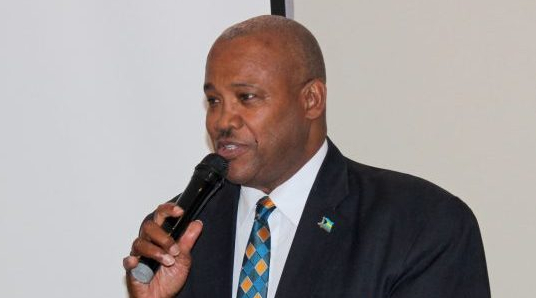By Desmond Brown
MADRID – In Sept. 2017, Dominica’s Douglas Charles Airport was severely damaged by flooding when Hurricane Maria hit the island with 160-mile-per-hour winds.
Rains brought by the hurricane also triggered landslides, and washed away bridges, roads and crops.
Climate Change and Disaster Risk Management Coordinator at the Organisations of Eastern Caribbean States (OECS) Crispin d’Auvergne says severe weather events like hurricanes Irma and Maria, serve as a reminder of the vulnerability of airports and seaports in the Caribbean.
“Hurricane Maria severely affected the air and seaports in Dominica. Anguilla was similarly impacted, as was St. Maarten, which has observer status at the OECS. So, they are being affected, seriously,” d’Auvergne said.
“Both air and seaports are critical for tourism, both in terms of cruise and stayover visitors.
“So, to the extent that our economies rely on air and seaports . . . then it’s important that we build resilience into those systems,” added d’Auvergne, who spoke with Caribbean News Service (CNS) on the sidelines of the United Nations Climate Conference (COP25), underway here until Dec. 13.

Recent United Nations Conference on Trade and Development (UNCTAD) studies on seaports and airports in Jamaica and Saint Lucia, show the economic effect of catastrophic climate events and what can be done to mitigate them.
In the studies, detailed assessments of the vulnerability of the islands’ transportation assets were carried out to improve knowledge and understanding at the national level; and to test new approaches in order to develop an appropriate methodology for assessing climate-related impacts on coastal transportation in other Small Island Developing States (SIDS).
Given the importance of airports and seaports and their land interconnections to tourism and the movement of goods, the vulnerability of their infrastructure and operations to climate variability and change is a most important factor for consideration, the studies note.
“Air and seaports are really key nodes in our supply system because, as an example, 90 per cent of our food and other supplies come by sea,” d’Auvergne said.
Urgent action needed
UNCTAD said SIDS already face several transport-related challenges as well as natural hazards and are particularly exposed due to their climate, geographical and topographical features as well as their critical reliance on coastal transport infrastructure, in particular seaports and airports.
According to d’Auvergne, climate-related extreme events affecting coastal transport infrastructure are likely to exacerbate existing challenges, making effective adaptation action an urgent imperative.
“Sea level rise is already happening and we’re already experiencing flooding that comes with the more intense rainfall that we see during hurricanes,” he said.
Resilience, not only in terms of structures, must be an important factor in all plans going forward, d’Auvergne said.
“In terms of operations for example, you would need to look at the actual terminals – how resilient they are in terms of water supply like in drought periods, because we can expect more intense droughts, more intense hurricanes. How quickly can they resume operations and how can they maintain operations during a drought?
“You also have to look at things like the road system that feeds to your ports. How robust are they? Are there bridges connecting them that will go down with the first hurricane or first heavy rain and flooding?
“When it comes to the airports themselves, it might mean gradually over time, looking at a phased approach to look at elevating your control towers. Gradually putting in costal armoring to prevent topping of waves,” d’Auvergne said.
- How Antigua and Barbuda is ‘transitioning from old ways to green ways’ with renewable energy
- ‘We are dying’: Island youth demand action from rich countries to meet scale of climate emergency
For countries planning to expand or renovate their airport, d’Auvergne said they should tart to put in some of those measures that can help to gradually increase their resilience.
“Your next upgrade should have a climate component in it so that you don’t lose your assists in the next hurricane that comes,” he said.
Many Caribbean airports tend to be located close to coastal areas – many below 33 metres – making them vulnerable to rising sea levels.
The lowest airport runway in the Caribbean is at the Sangster International Airport in Montego Bay, Jamaica, which sits only four metres above sea level.
Trotz: ‘We can’t help where they are at this point’
The location of the airports in the Caribbean is a reality these countries have to live with, said Dr. Ulric Trotz, Deputy Director at Science Advisory at the Caribbean Community Climate Change Centre (CCCCC).
“Our ports and airports are in very vulnerable areas. We can’t help where they are at this point in time, there’s been tremendous investment,” he told CNS.
“What we could do is to try and understand what the impacts of higher seas would be and try to put in protection. We have an example in Palisadoes in Jamaica [Norman Manley International], if you look at what has been done over the last few years, it’s precisely what we need to look at doing at other exposed airports throughout the Caribbean.”
Dr. Trotz suggests countries study what the inundation would be like, using different scenarios, such as a category one hurricane, a category two hurricane, or high tides.
He said this would give countries an idea of the scope of exposure, and on that basis, they could then look at how to re-engineer the actual location to protect the airports.
Limited financial resources
While this remedy could give countries up to 90 per cent protection, Dr. Trotz acknowledged that it’s easier said than done, given the limited financial resources available to countries in the Caribbean.
“But one of the problems of course – it’s easy sitting here talking about it – is getting the resources to do it,” he said.
“If we look at my country, Guyana, forget the airport, we’re on the coast six feet below sea level. We’re there basically, I think, as a result of our colonization by the Dutch who had all the technology to put up sea walls, etc.

“We don’t have the resources to deal with the new reality of rising sea level and the extreme weather events that we experience, so we get frequent flooding. The Dutch on the other hand, in Amsterdam, they put up a flood defense system for a one-in-a-thousand-year event, which shows that globally we have the know-how to deal with our problems.
“The problem is we don’t have the resources. We don’t even have the resources to deal with a yearly flooding event much less a one-in-a-thousand-year event. It needs a lot of investment. It needs a lot of cooperation from some of our developed country partners. But I’m hopeful that we’ll get the resources to do just what is needed to be done,” Dr. Trotz added.




